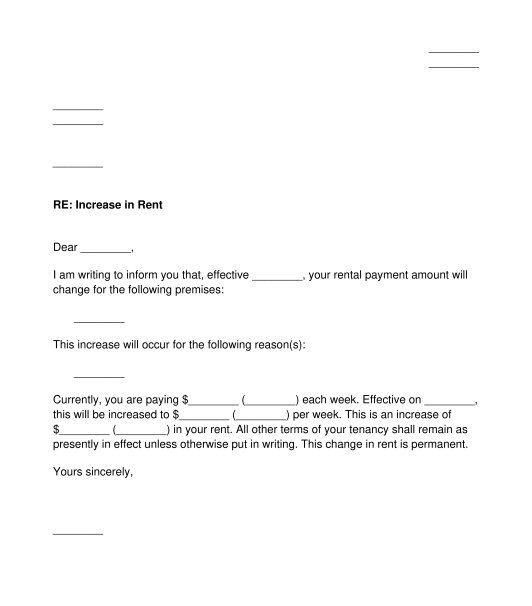 29/09/2025
29/09/2025

Answer a few questions and your document is created automatically.

Your document is ready! You will receive it in Word and PDF formats. You will be able to modify it.

 29/09/2025
29/09/2025
 Word and PDF
Word and PDF
 1 page
1 page
A Rent Increase Notice can be used by a landlord to inform tenants in a rental property that their rental payments will be increasing. By using a Rent Increase Notice, the change in rent is documented in writing, preventing misunderstandings, miscommunication, and future disputes over the rent amount due.
From time to time, landlords may want to increase the rent that they charge their tenants. For example, landlords often do this once per year, or when they renew the lease.
When doing this, landlords often choose to send a written notice to tenants, confirming that rent will be increased. The notice helps landlords to notify tenants that they are doing this, and to provide a written record of the new arrangements.
Yes, for residential leases in Australia, it is generally mandatory for the landlord to provide notice in writing before increasing the rent. There is also a mandatory notice period which is set out in state and territory residential tenancy legislation, and is often around 60 days' written notice.
For commercial leases, the rules are a bit less straightforward. Often the lease itself will discuss rent increases and how they may occur. In any case, it is good practice to use a Rent Review Notice regardless.
Before finalising a Rent Review Notice, the landlord should review their lease and any relevant tenancy laws to make sure they are legally entitled to increase the rent.
The landlord should also review their lease and relevant tenancy laws to see whether there are any requirements regarding how this notice should be provided, or how much notice must be provided. For example, in many cases, the lease might say something about the form of notice (for example, whether it can be provided electronically such as by email, or whether it needs to be provided in hard copy and/or by registered post). There might be rules regarding the address(es) to which it must be sent. There might also be rules regarding the amount of notice that the landlord must provide - in other words, how long before the rent increase takes effect, that this notice must be provided.
The Rent Review Notice may be prepared by the landlord and given to the tenant. Alternatively, if the landlord uses a property manager, then it may be prepared by the property manager.
Once the Rent Review Notice has been filled out, the landlord can sign and date it and provide a signed copy to all tenants on the lease. The landlord should retain a copy of the notice for their own records, as well as evidence of the fact that they have provided the notice (for example, a send receipt or a copy of an email confirmation), in case the tenant later disputes having received the notice.
Often the lease will specify how a Rent Review Notice should be provided to the tenant. It might say something about the form of notice (for example, whether it can be provided electronically such as by email, or whether it needs to be provided in hard copy and/or by registered post). It might specify exactly which email address or postal address the notice should be delivered to. There might also be rules regarding the amount of notice that the landlord must provide.
Therefore, the landlord should make sure to comply with any of these requirements.
A Rent Review Notice should contain:
Different laws may apply to this matter depending on which state or territory the property is located in, and whether the property has been leased for residential, commercial or retail purposes.
Retail leases are a sub-category of commercial leases (usually for properties that involve a "retail" element, such as a shop front). The laws in each state and territory regarding retail leases also provide more protections to tenants of retail properties than those of ordinary commercial properties.
Each state and territory also has its own legislation regarding residential tenancies.
Leases are also subject to general principles of contract law, as provided by the common law.
Further information or legal assistance, particularly in relation to residential properties is available from consumer affairs offices, tenant unions or tenant advice services in each state and territory. Community legal centres may also provide assistance.
You fill out a form. The document is created before your eyes as you respond to the questions.
At the end, you receive it in Word and PDF formats. You can modify it and reuse it.
Guides to help you
Rent Increase Notice - sample template - Word and PDF
Country: Australia